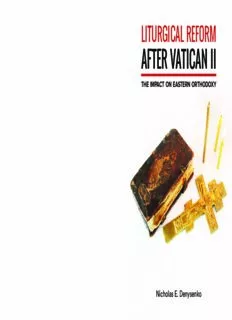
Liturgical Reform After Vatican II: The Impact on Eastern Orthodoxy PDF
Preview Liturgical Reform After Vatican II: The Impact on Eastern Orthodoxy
D the cross-poLLination e n LiturgicaL reform of LiturgicaL tradition y s e This study examines Orthodox liturgical reform after Vatican II through the lens of Catholic- n Orthodox ecumenical dialogue. Examining the initial pillars of liturgical reform, the study k after Vatican ii o presents the history of movements for liturgical reform through four models: the liturgical reforms of Alexander Schmemann; the alternative liturgical center in the Russian Orthodox Church Outside of Russia; the symposia on liturgical rebirth authorized by the Church of Greece; and the renewed liturgy of New Skete Monastery, and concludes with suggestions for liturgical reform that meet the challenges of postmodernity and ecumenical fidelity. The ImpacT on easTern orThodoxy aL i ft tu er Praise for Liturgical Reform after Vatican II rg i “This is a wonderful book which merits wide ecumenical attention and study as it demonstrates Vc the mutual influence of East and West in the Liturgical Movement and in subsequent programs aa of liturgical renewal and change.” tL ir maxweLL Johnson c e University of Notre Dame af o n “Nicholas Denysenko offers the first critical study and constructive evaluation of the efforts for r liturgical reform in the Orthodox Church in dialogue with the liturgical reform promulgated by im i Vatican II in the Catholic Church. His outstanding work is scholarly yet pastoral, historical yet current, thorough yet straightforward, and should be read by all, scholars, clergy, and laity who study, love, and live the liturgy.” stefanos aLexopouLos Catholic University of America Nicholas E. Denysenko is associate professor of theological studies and director of the Huffington Ecumenical Institute at Loyola Marymount University in Los Angeles, California. Denysenko researches Byzantine liturgical history, sacramental theology, contemporary pastoral theology, and religion in Ukraine. His most recent book is Chrismation: A Primer for Catholics (2014). Denysenko is a deacon in the Orthodox Church in America. Religion / Ecclesial Theology Nicholas E. Denysenko Liturgical Reform After Vatican II Liturgical Reform After Vatican II The Impact on Eastern Orthodoxy Nicholas E. Denysenko Fortress Press Minneapolis LITURGICAL REFORM AFTER VATICAN II The Impact on Eastern Orthodoxy Copyright © 2015 Fortress Press. All rights reserved. Except for brief quotations in critical articles or reviews, no part of this book may be reproduced in any manner without prior written permission from the publisher. Visit http://www.augsburgfortress.org/copyrights/ or write to Permissions, Augsburg Fortress, Box 1209, Minneapolis, MN 55440. Cover image: a-poselenov, ThinkstockPhotos-470923502 Cover design: Joe Reinke Library of Congress Cataloging-in-Publication Data Print ISBN: 978-1-4514-8615-5 eBook ISBN: 978-1-5064-0144-7 The paper used in this publication meets the minimum requirements of American National Standard for Information Sciences — Permanence of Paper for Printed Library Materials, ANSI Z329.48-1984. Manufactured in the U.S.A. This book was produced using Pressbooks.com, and PDF rendering was done by PrinceXML. To Kevin Irwin, Dominic Serra, and Mark Morozowich Friends and Teachers for steadfast encouragement Contents Acknowledgments ix Publication Credits xi List of Tables xiii Preface xv Introduction 1 1. Sacrosanctum Conciliumand Ecumenical 35 Ressourcement 2. Alexander Schmemann’s Eucharistic Revival 81 3. A Russian Alternative 143 Liturgical Maximalism in ROCOR 4. Contemporary Liturgical Renewal in the Church 205 of Greece 5. Liturgical Scholarship and Monastic Reform 259 New Skete Monastery 6. Lessons from History 303 Assessments and an Agenda for Liturgical Reform 7. Conclusion 357 Bibliography 403 Index 431 Acknowledgments Many people helped me think about and write this book. First, I thank my teachers at The Catholic University of America, Msgr. Kevin Irwin, Father Dominic Serra, and Father Mark Morozowich, whose passion and love for the liturgy inspired me to study it critically, andreceiveitasagift oftheHolySpirit. Iamalsothankful to Paul Meyendorff, who not only continues Alexander Schmemann’s work at St. Vladimir’s Seminary, but enriches it by exposingstudentstotherichesofthemethodofcomparativeliturgy. Numerous friends and colleagues directed me to precious sources, read chapters, assisted with translations, and commented on excerpts and ideas, especially Father MichaelPlekon, Father Stefanos Alexopoulos, Deacon Andrei Psarev, Sister Vassa Larin, Father Alkiviadis Calivas, Father Peter Galadza, Father Cyril Hovorun, Father Thomas Pott, Deacon Paul Gavrilyuk, Petros Vassiliadis, Daniel Galadza, Elizabeth Ledkovsky, David Drillock, Alexander Lingas, Vitaly Permiakov, and Roberto Dell’Oro. I would like to single out Brother Stavros Winner, the ecclesiarch at New Skete Monastery, who read several chapters and provided me with precious background on New Skete’s process of studying the liturgy and developing its own Typikon: thank you! Thank you to Eleana Silk and Matthew Garklavs who granted me access to the ix
Description: